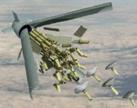|
Cluster Bomb Information |





|
What are cluster bombs? Large weapons of mass destruction, deployed from land or air. Upon air deployment hundreds of submunitions are released these are known as bomblets, from the ground they are very like grenades. The submunitions scatter over the area exploding on impact. Developments Recent engineering developments have produced GPS precision guided weapons still contain submunitions which separate on detonation, but they actively seek out targets. Uncertainty as to whether they will be approved or instead categorised as cluster bombs. Uses USSR, US and UK being big players who have used them. They are stockpiled and produced in over 76 countries. The problem Indiscriminative does not distinguish between enemy and civilians. Humanitarian when dropped in built up area they have a mass impact. Failure rate causes them to become antipersonnel mines which are much more likely to cause death. Antipersonnel mines where banned in 1997 Inadequate help to clear contaminated areas and assist survivors They are not precise of the 663 only 33.6% impacted on the target area (pg16 cluster munition), shrapnel is projected over a radius of up to 50mx Facts · United kingdom signed the treaty in December 2008 in OSLO however have not yet ratified it. · Caused more civilian casualties in Iraq 2003 and Kosovo 1999 than any other weapon system · The UN estimates up to 1 million submunitions were left unexploded after the conflict between Hezbollah and Israel in July and August 2006. |


|
Analysing the social and ethical implications of military development |
|
Military Technology Out of Control? |

|
FACTS AND FIGURES |
|
Fragment injury |
Physical |
Effect |
|
Limbs |
- The fragment passes straight through the skin - Muscle is not very elastic and so is torn. Muscles have a rich blood supply so a lot of blood is produced. - Bones arent elastic either so when the fragment hit the bone it is bought to a complete stop sending massive shockwaves throughout. |
- The body is 70% water. The fragment acts like a stone hitting water, sending pressure and waves into tissues. |
|
Arteries |
- Small tears in arteries due to fragments or bone. - They are plugged by platelets. And because the tear will be small, bloody rarely pumps out. - Blood collects inside the limb approximately 1-2 litres. |
- Artery bleeding is hidden. - Due to unseen blood losses blood flow in the arteries slows down. If the blood fails to clot or the clot is removed the person bleeds to death. |
|
Organs |
- Skull injuries airway problems and face problems. - Chest injuries usually have major tears in heart and blood vessels. - Air leaking from lungs is also another problem restricting breathing. - The abdomen contains kidneys, liver and spleen which have rich blood supplies. Breathing is reduced as diaphragm movement is restricted. |
- Death is certain within a few hours for skull and chest injuries. - Brain damage is likely with face injuries. - If the chest injury is to the side, survival rate is significantly increased. - the abdomen collects 2-3 litres of blood without any swelling,, death from blood loss and low blood pressure and lack of oxygen. |